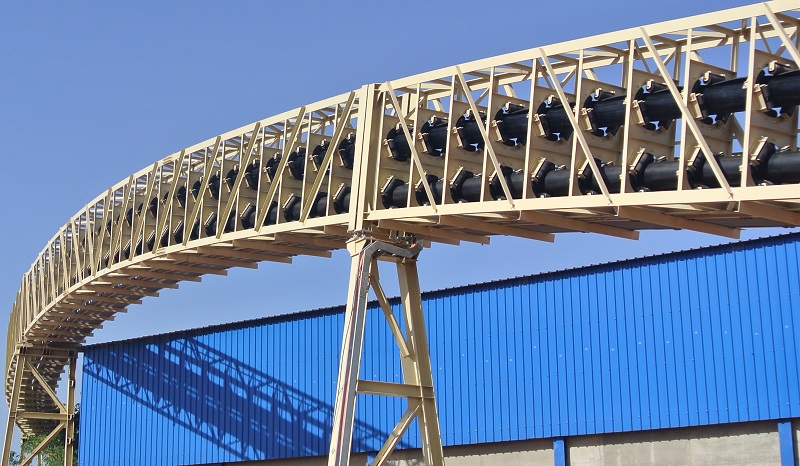How does pipe conveyor work?
How does pipe conveyor work?
A pipe belt conveyor is a unique conveying system that conveys material from its origin to its destination through pipes. Pipe belt Conveyors are more efficient and take up less space than traditional belt conveyors. The working principle of the pipe belt conveyor will be described in detail below.

The working principle of the pipe belt conveyor can be divided into the following steps:
1. Loading materials: The materials are first loaded into the feed port of the starting point through the loading equipment. This can be a loading hopper, a hopper or other loading device, depending on the specific application needs.
2. Feed section: The feed section where the material enters the pipeline. The feed section is usually an inclined pipe, through the design of the inclined angle, the material can flow downward naturally.
3. Conveying section: The material is propelled in the conveying section of the pipeline. The delivery section consists of a series of pipe sections that are joined together by special connectors. In the conveying section, the material is pushed by compressed gas or liquid to make it advance along the pipeline.
4. Discharge section: When the material reaches the end point, it is released through the discharge section. The discharge section is usually an inclined pipe, and the material can flow out naturally.
The working principle of the pipe belt Conveyor relies on the auxiliary propulsion of compressed gas or liquid. This pushing method reduces the friction between the material and the pipe wall, thereby reducing energy loss and wear. In addition, the pipe belt conveyor can also transport materials on horizontal, vertical and curved paths, suitable for various complex scenarios.
Pipe belt conveyors are widely used in many industries, including mining, chemical industry, electric power, construction materials, etc. It can convey various types of materials, such as coal, ore, powder, granules, etc. Due to its high efficiency, energy saving and environmental protection features, the pipe belt conveyor has become an important equipment in the field of modern material transportation.
In short, the pipe belt conveyor transports the material from the starting point to the end point through the pipeline, relying on the auxiliary push of compressed gas or liquid. Its working principle is simple and efficient, and it is suitable for various industries and material conveying needs.
 O'zbek
O'zbek slovenský
slovenský Azərbaycan
Azərbaycan Қазақ
Қазақ Latine
Latine ລາວ
ລາວ български
български नेपाली
नेपाली فارسی
فارسی Javanese
Javanese Українська
Українська Lietuvos
Lietuvos Română
Română Slovenski
Slovenski پښتو
پښتو Punjabi
Punjabi Bosanski
Bosanski Malti
Malti Galego
Galego Afrikaans
Afrikaans Esperanto
Esperanto 简体中文
简体中文 Српски
Српски मराठी
मराठी Ελληνικά
Ελληνικά čeština
čeština Polski
Polski ไทย
ไทย Nederlands
Nederlands Italiano
Italiano Tiếng Việt
Tiếng Việt Deutsch
Deutsch français
français русский
русский Português
Português Español
Español 한국어
한국어 Svenska
Svenska Malay
Malay اردو
اردو norsk
norsk Indonesia
Indonesia عربى
عربى Gaeilge
Gaeilge Türk
Türk Pilipino
Pilipino हिन्दी
हिन्दी Dansk
Dansk বাংলা
বাংলা English
English


Juli Engineering Leads the Industry as a Trusted Belt Conveyor Manufacturer
As global industries continue to modernize production and logistics systems, the demand for durable, efficient, and high-performance material handling equipment has never been greater. Among the key players driving this evolution, Juli Engineering has established itself as a leading name among Belt Conveyor manufacturers, offering innovative solutions that enhance productivity, safety, and operational efficiency across a wide range of sectors.
Read MoreJuli Engineering Unveils High-Efficiency Enameled Tube Preheaters for Industrial Applications
In an era where energy efficiency and environmental responsibility are top priorities, Juli Engineering is setting new standards in industrial heat exchange technology with its latest range of Enameled Tube Preheaters. Designed to deliver superior heat transfer performance, corrosion resistance, and long-term durability, these preheaters are helping industries enhance energy recovery and reduce emissions.
Read MoreJULI Emerges as a Leading Pipe Belt Conveyor Manufacturer Driving Innovation in Material Transport
In the evolving landscape of bulk material handling, pipe belt conveyors have gained global recognition for their ability to combine efficiency, environmental protection, and long-distance conveying capabilities. Among the top pipe belt conveyor manufacturers, JULI stands out for its advanced engineering, exceptional product quality, and commitment to sustainable industrial development.
Read More